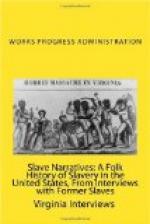Edited By:
Mrs. Sarah H. Hall
Athens, Georgia
and
John N. Booth
WPA Residencies 6 & 7
August 29, 1938
The bareness of Minnie Davis’ yard was relieved by a single rosebush, and her small house might best be described as a “tumble-down shack.” An unsteady wooden box served as a step to the fragment of porch before the front door.
“Good mornin’, Mam,” was the greeting of a Negro man who hastened to answer the visitor’s knock at the door. “Yes Mam, Miss Minnie’s at home.” He turned, tapped on the door of one of the four rooms adjoining the hall, and called: “Miss Minnie, a white lady wants to see you.” Minnie hobbled to the door and invited the visitor to her bedroom, where a suite of handsome walnut furniture reflected the period when marble tops were standard parts of dressers and washstands. A low chair, an old table, and a rusty heater completed the furnishings of the room.
Age and ill health have not dealt kindly with Minnie, and her short-cut, kinky hair is almost white, but her eyes and face retain a remarkably youthful appearance. She is a small thin woman of gingercake color and, despite the sweltering heat, she wore a pink flannel nightgown, faded and dingy, and a pair of high top black shoes, so badly run over that she hobbled along on the sides of them. Minnie is well educated, and she taught school for so long that her speech is remarkably free of dialect.
When the nature of the visit was explained, Minnie said: “A white woman has been here several times before, but I was sick and didn’t understand clearly what she wanted me to tell her.” She then explained that she did not care to talk for publication at all. She said she was hungry and had nothing at all in the house to eat. Her nephew, Ed, an ex-postman lived with her, she explained, and he would go for food if there was any money. She might feel like talking a little if she had a little something to eat. The interviewer provided the cash and Ed soon returned with a pint of milk and some cinnamon rolls. After her repast, Minnie began to talk, giving the impression that every word was carefully weighed before it was uttered.
“I was born in Greene County near Penfield, Georgia,” she said. “Aggie Crawford was my mother and she was married to Jim Young. My only sister was Mariah, and my three brothers were Ned, John, and Jim. Ned was a mulatto. I know who his father was, but of course you won’t ask me that. I wouldn’t want to expose my own mother or the man who was Ned’s father. I was quite a small child during the war period, and I can tell you very little of that time, except the things my mother told me when I grew old enough to remember. My mother belonged to the Crawford family in Greene County, but when I knew anything we were living in Athens and were the slaves of Marster John Crawford.




